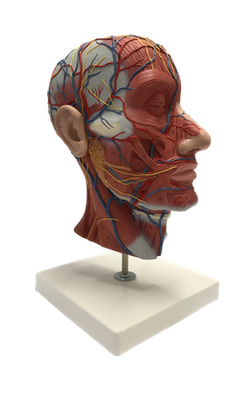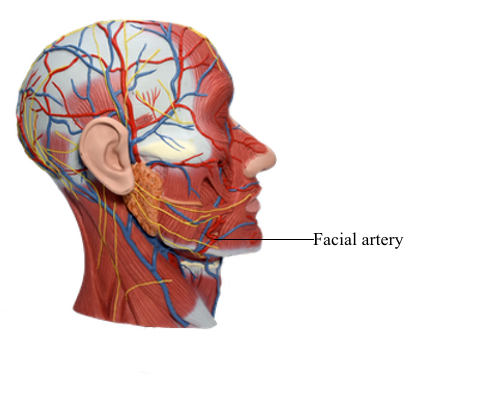Main Model

Blood Vessels : 57 Facial artery

Facial artery arises anteriorly from the external carotid artery, either in common with the lingual artery or immediately superior to it. After giving rise to the ascending palatine artery and a tonsillar artery, the facial artery passes superiorly under cover of the digastric and stylohyoid muscles and the angle of the mandible. It loops anteriorly and enters a deep groove in and supplies the submandibular gland. It then gives rise to the submental artery to the floor of the mouth and hooks around the middle of the inferior border of the mandible to enter the face.
The face is richly supplied by with superficial arteries and external veins, as is evident in blushing and blanching (e.g., becoming pale due to cold). The terminal branches of both arteries and veins anastomose freely, including anastomoses across the midline with contralateral partners.
Superficial Arteries of Face
Most superficial arteries of the face are branches or derivatives of branches of the external carotid artery. The facial artery provides the major arterial supply to the face. It arises from the external carotid artery and winds its way to the inferior border of the mandible, just anterior to the masseter. The artery lies superficially here, immediately deep to the platysma. The facial artery crosses the mandible, buccinator, and maxilla as it courses over the face to the medial angle (canthus) of the eye, where the superior and inferior eyelids meet. The facial artery lies deep to the zygomaticus major and levator labii superioris muscles. Near the termination of its sinuous course through the face, the facial artery passes approximately a finger's breadth lateral to the angle of the mouth. The facial artery sends branches to the upper and lower lips (superior and inferior labial arteries), ascends along the side of the nose, and anastomoses with the dorsal nasal branch of the ophthalmic artery. Distal to the lateral nasal artery at the side of the nose, the terminal part of the facial artery is called the angular artery.
The superficial temporal artery is the smaller terminal branch of the external carotid artery; the other branch is the maxillary artery. The superficial temporal artery emerges on the face between the temporomandibular joint (TMJ) and the auricle, enters the temporal fossa, and ends in the scalp by dividing into frontal and parietal branches. These arterial branches accompany or run in close proximity to the corresponding branches of the auriculotemporal nerve.
The transverse facial artery arises from the superficial temporal artery within the parotid gland and crosses the face superficial to the masseter, approximately a finger's breadth inferior to the zygomatic arch. It divides into numerous branches that supply the parotid gland and duct, the masseter, and the skin of the face. It anastomoses with branches of the facial artery.
In addition to the superficial temporal arteries, several other arteries accompany cutaneous nerves in the face. Supra-orbital and supratrochlear arteries, branches of the ophthalmic artery, accompany nerves of the same name across the eyebrows and forehead. The supra-orbital artery continues and supplies the anterior scalp to the vertex. The mental artery, the only superficial branch derived from the maxillary artery, accompanies the nerve of the same name in the chin.
Facial artery
Origin: External carotid artery
Course: Ascends deep to submandibular gland; winds around inferior border of mandible and enters face
Distribution: Muscles of facial expression and face